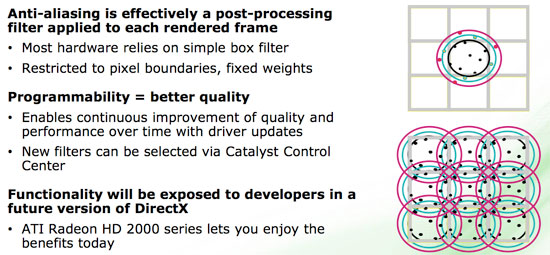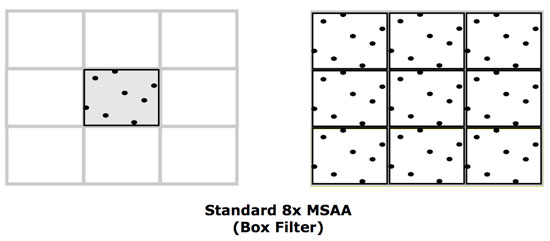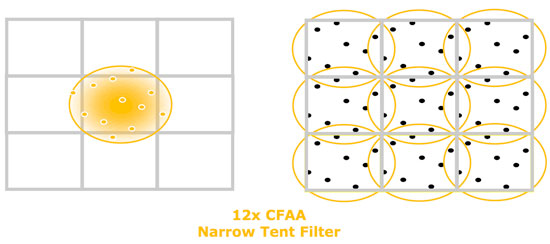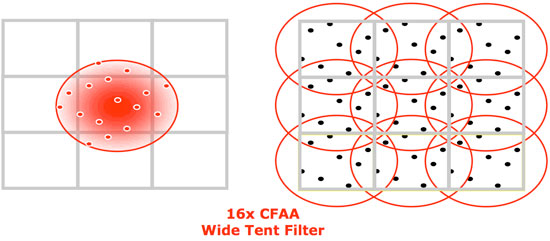ATI Radeon HD 2900 XT: Calling a Spade a Spade
by Derek Wilson on May 14, 2007 12:04 PM EST- Posted in
- GPUs
CFAA and No Fixed Resolve Hardware
That's right, R600 doesn't have hardware dedicated to resolving MSAA in the render back end - the only MSAA related tasks handled in the render back end are compression and evaluation of the subpixels. All antialiasing resolve is performed on the shader hardware. Certainly, AMD would prefer we start by telling you about the neat custom resolve filters that can be implemented on their shader hardware, but we would rather speculate about this for a moment first.
AMD has stated that, moving forward, in addition to allowing programmable sample patterns, future DX versions may allow for custom resolve filters as well. This is cited as one of the reasons why R600 uses shader hardware to resolve AA samples. AMD has given us a couple different resolve filters to play with, which we'll talk about in a minute. But at a point where we're seeing the first DX10 hardware from graphics makers, and at a time where competitive performance is paramount, it doesn't seem like the decision we would have made.
Whatever the circumstances, R600 sends its pixels back up from the render back ends to the shader hardware to combine subpixel data into a final pixel color. In addition to the traditional "box" filter (which uses subpixels within the area of a single pixel), the new driver offers the ability to use subpixel data from neighboring pixels resolved with a tent filter (where the impact of the subpixels on final color is weighted by distance). AMD calls this CFAA for custom filter antialiasing.

AMD currently offers narrow and wide tent filters which can be implemented using 2, 4, or 8 multisamples per pixel boundary. This gives us nine different AA options including traditional box filters. More filter options can be provided via driver updates, as these are essentially driver managed shader programs. Here's the breakdown of the options based on the type of filter and the number of samples used to resolve each pixel.



One of the useful side effects of these tent filters is that they are also capable of antialiasing interior pixels, not just those covered by more than one triangle. This is helpful in getting rid of aliasing in textures which can occur in certain cases.
While tent filters are a very interesting idea to improve antialiasing, they are not without their drawbacks. First, it is possible for tent filters, even though neighboring subpixel data is weighted less than internal subpixels, to create a muddy look, especially with high contrast fine detail like thin text for example. While tent filters can antialias textures on interior pixels, they can also create a blur effect where it isn't needed which removes detail from the scene.
Edge Detection
While tent filters are good in the general edge case, in order to be really compelling from an image quality stand point, AMD decided to go a step further and adaptively apply more AA in places where it would do the most good and less elsewhere. This will be done by applying an edge detect algorithm to the framebuffer and using more aggressive AA on these edges.
We learned that edge detection can be sped up by looking at pixel compression. If all the subpixels for one fragment are the same color, compression will be at its highest and there is no edge within that pixel. Beyond using this information, we are told that the algorithm uses straightforward derivative computations to find high frequency data (high contrast edges) much the same way Photoshop does.
The combination of edge detection and tent filters gives us two extra option beyond the ones listed above: 12x narrow tent filter with edge detect and 24x wide tent filter with edge detect. These filters are capable of very good image quality, though this quality does come at a performance cost. We will take a look at performance and image quality after we finish going through R600 hardware.










86 Comments
View All Comments
TA152H - Monday, May 14, 2007 - link
Fanboy? What a dork.I've had success with ATI, not with NVIDIA, and I know ATI stuff a lot better so it's just easier for me to work with. It's not an irrational like or dislike. I bought one NVIDIA and it was a nightmare. Plus, I'm not as sure they'll be around for very long as I am ATI/AMD, although they had a good quarter, and AMD surely had a dreadful one.
Selling discrete video cards alone might get a lot more difficult with the integration of CPUs, and GPUs.
yyrkoon - Monday, May 14, 2007 - link
You are a fanboy, face it. 'I tried a nVidia card once . . .' How long ago was that ? Who made the card ? Did you have it configured properly? Once?! Details like this are important, and seemily/conviently left out. Anyhow, anyone claiming that nVIdia cards are 'junk' has definate issues with assembling/configuring hardware. I say this because my current system uses a nVidia based card, and is 100% rock solid. 'Person between the chair and keyboard' rings a bell.Ask any Linux user why they refuse to use ATI cards in their system . . . You are also one of these people out there that claims ATI driver support is superior to nVIdias driver support I suppose ? If you have truely been using ATI products for 20 years, then you know ATI has one of the worst reputations on the planet for driver support(and while it may have improved, it is not as good as nVidias still).
Yeah, anyhow, ATI, and nVidia both can have problems with their hardware, it is not based 100% on their architecture, but the OEM releasing the products have a lot of effect here also. There are bad OEMs to buy from here on both sides of the fence, knowing who to stay away from, is half the work when building a PC, and probably had a lot more to do with your alleged 'bad nVIdia card', assuming you actually configured the card properly.
I also had a problem with an nVIdia card once, I bought a brand new GF3 card about 7 years ago, and a few of the older games I had, would not display properly with it. What did I do ? I waited about a month, for a new driver, and the problem was solved. I have also had issues with ATI cards, one of which drew too much power from the AGP slot, and would cause the given system to crash 1-2 times a day. This was a design issue/oversight on ATI's behalf(the card was made by Saphire, who also makes ATIs cards). What did I do ? I replaced the card with an nVIdia card, and the system has been stable since.
So you see, I too can skew things to make anyone look bad also, and in the end, it would only serve to make me look like the dork. But if you want to pay more, for less, that is perfectly fine by me.
Pirks - Monday, May 14, 2007 - link
I've got all problems and crappy drivers (especially Linux ones) only from ATI while nVidia software was always much better in my experience. power hungry noisy monsters made by whom? by ATI! as always :) same shit as with their x1800/x1900 miserable power guzzling seriesdiscrete video cards are not going away any time soon. ever heard of integrated video used in games, besides ones from 2000, like old Quake 2? no? then please continue your lovefest with ATI, but for me - it looks like I'll pass on them this time again - since Radeon 9800Pro they went downhill and continue in that direction. they MAY make a decent integrated CPU/GPU budget-oriented vendor in a future, for all those office folks playing simple 2D office games, but real stuff? nope, ATI is still out of the game for me. let's see if they manage to come back with reincarnation of R300 in future.
ironically, AMD CPUs on the other hand have best price/performance ratio, so intel won't see me as their customer. I wish ATI 3D chips were as good as AMD CPUs in that regard (and overclockers please shut up, I'm not bothering to OC my rig because I don't enjoy benchmark numbers, I enjoy REAL stuff like games, and Intel is out of the game for me as well, at least until their budget single core Conroes are out)
utube545 - Tuesday, May 22, 2007 - link
Get a clue, you fucking cretin.dragonsqrrl - Thursday, August 25, 2011 - link
haha... lol, wow. facepalm.dragonsqrrl - Thursday, August 25, 2011 - link
Damn you're a fail noob of an ATI fanboy. Time has not been kind to the HD2900XT, and now you sound more ridiculous then ever... lol.yzkbug - Monday, May 14, 2007 - link
Not a word about new AVIVO HD and digital sound features?DerekWilson - Wednesday, May 16, 2007 - link
we mentioned this ...on the r600 overview page ...
photoguy99 - Monday, May 14, 2007 - link
First to be clear and I do not condone the title of this article, there's no need to bring racism into this.But my point is NVidia can and will react by making the performance per dollar competitive for the R600 vs 8800GTS.
Once the prices are comparable, why buy a more power hungry part (the ATI)?
This is one disadvantage they can't correct until the next respin.
DrMrLordX - Monday, May 14, 2007 - link
Based on the benchmarks results, the only reason I can see for getting 2900XTs is if a). you don't care about power consumption and b). want to run a Crossfire rig at a lower cost of entry than dual-8800 GTXs or 8800 Ultras.As others have said, some more benchmarks in mature DX10 titles might show who the real winner here is performance-wise, and that holds true for multi-GPU scenarios as well.